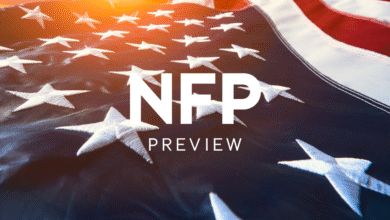Monday Markets Turn Green as Tariff Optimism Spreads

- Goldman Sachs Downgrades Super Micro Computer to Sell
- Tesla Pursuing Chinese Approval for Advanced Driver-Assistance Features
- AZEK Shares Surge Following $8.75 Billion Acquisition by James Hardie
- Jefferies Upgrades FedEx to Buy on Cost-Cutting Progress
Major US index futures are showing mixed performance. The S&P 500 (US500) is up +1.19% to 5797.7, while the Dow (US30) has risen +0.72% to 42776. Nasdaq futures (US100) are showing a significant gain of +1.21% to 2111.1, and the Russell 2000 (US2000) is up 1.2%.
European markets are predominantly negative, with most indices in the red. Germany’s DAX (DE40) index is down -0.01% to 23135.3, while France’s CAC 40 (FRA40) index has fallen -0.14% to 8038.4. Spain’s IBEX 35 (SPA35) is flat at 0.00% at 13314. The Euro Stoxx 50 (EU50) has gained slightly by +0.04% to 5362.6, and Switzerland’s SMI (SUI20) is down -0.33% to 12814. The UK’s FTSE 100 (UK100) index has increased +0.04% to 8656.0, and the Netherlands’ AEX (NED25) has gained +0.25% to 917.50. Other European markets include Austria’s ATX (AUT20) up +1.22% to 4145, Italy’s FTSE MIB (ITA40) showing +0.04% gains to 38296, and Poland’s WIG 20 (W20) up +1.32% to 2754.6.
S&P 500 Sectors Show Mixed Performance. Source: Bloomberg Financial LP
Current volatility observed on Wall Street. Source: xStation

The Nasdaq-100 index, represented by the US100 contract, is approaching the 200-day SMA, which has previously acted as support. After the retest, bulls may target the 38.2% Fibonacci retracement level, while bears will aim for a retest of the 61.8% Fibonacci retracement level. The RSI is in bullish divergence near 48.5, a level that has previously served as strong support in an uptrend. Meanwhile, the MACD is reclaiming bullish divergence. Source: xStation
Market News
- Goldman Sachs Downgrades Super Micro Computer to Sell: Goldman Sachs analyst Michael Ng downgraded Super Micro Computer to sell from neutral on Monday, setting a price target of $32 which implies a 24% decrease from the last close. The downgrade reflects concerns about AI server competition and margin pressures. Super Micro shares fell 3.1% in premarket trading following the announcement. Despite the downgrade, the company maintains six buy ratings, ten hold ratings, and now two sell ratings among analysts tracked by Bloomberg, with an average price target of $57.42. The stock has risen 38% this year as of the last close.
- Tesla Leads Magnificent Seven Gains as Retail Investors Flock to Stock: Tesla shares jumped 7% on Monday, leading gains among the Magnificent Seven tech stocks as retail investors continue their buying spree. According to JPMorgan Chase data, individual investors have been net buyers of Tesla shares for 13 consecutive sessions through Thursday, pumping $8 billion into the stock. Other Magnificent Seven stocks also showed strong performance, with Meta rising 1.7%, Nvidia and Amazon both up 1.5%, Alphabet gaining 1.2%, Microsoft up 1.1%, and Apple advancing 0.9%. The broader rally comes amid signs that President Trump’s next round of tariffs may be more measured than previously suggested. The Bloomberg Magnificent 7 index has fallen 14% this year after surging 67% in 2024.
- Tesla Pursuing Chinese Approval for Advanced Driver-Assistance Features: Tesla is advancing the process of obtaining Chinese regulatory approval for its more advanced driver-assistance functions in hardware 3.0 and 4.0, according to a statement from Tesla’s client support account on Weibo. The company plans to roll out its smart driving-assistance feature in China after completing approval of the relevant software. This development follows China’s industry ministry issuing new rules in late February requiring autonomous driving-related over-the-air software upgrades to be subject to regulatory approval, which had caused Tesla to pause its previously scheduled free trial of Full Self-Driving service in China.
- AZEK Shares Surge Following $8.75 Billion Acquisition by James Hardie: Shares of home-decking provider AZEK jumped as much as 21% after Australian building-materials company James Hardie Industries agreed to acquire the business in a cash and stock deal valued at $8.75 billion. James Hardie shares closed down 15% in Sydney trading following the announcement, wiping approximately A$2.9 billion from the company’s market value. Analysts view the deal as favorable for AZEK shareholders, with JPMorgan noting it represents a 26% premium versus AZEK’s average price for 2024. Market observers don’t expect regulatory hurdles for the acquisition, which combines leaders in the exterior building products categories of fiber cement siding and composite decking.
- Jefferies Upgrades FedEx to Buy on Cost-Cutting Progress: Jefferies upgraded FedEx from hold to buy, expressing confidence in the parcel delivery company’s ability to continue growing earnings regardless of top-line trends as it executes on its cost-cutting plans. Analyst Stephanie Moore wrote that investors are “ignoring the idiosyncratic cost transformation going on at FDX under the surface,” and anticipates the company’s Network 2.0 and Tri-Color cost plans will significantly contribute to profit growth over the next two years. The firm set a price target of $275, implying a 19% increase from the last close. FedEx stock gained less than 1% in premarket trading.
- Cryptocurrency Stocks Rally as Bitcoin Approaches $90,000: Cryptocurrency-exposed stocks advanced as Bitcoin gained for a second straight session, rising 3% to $87,655. Notable gainers included Strategy (+5.2%), Coinbase Global (+4.5%), Riot Platforms (+4.4%), and MARA Holdings (+4%). The rally comes amid research from Standard Chartered suggesting Bitcoin may have evolved beyond just being a hedge against traditional finance risks and is increasingly behaving like a Nasdaq-listed tech stock. The bank’s Head of Digital Asset Research, Geoffrey Kendrick, created a hypothetical “Mag 7B” index replacing Tesla with Bitcoin in the Magnificent Seven basket, finding it generated both higher returns and lower volatility compared to the original index. Bitcoin’s price movement lifted the total market cap of the crypto industry by 1.5% to $2.9 trillion.
Other news coming from individual S&P 500 index companies. Source: Bloomberg Financial LP
The material on this page does not constitute financial advice and does not take into account your level of understanding, investment objectives, financial situation or any other specific needs. All information provided, including opinions, market research, mathematical results and technical analyzes published on the Website or transmitted To you by other means, it is provided for information purposes only and should in no way be construed as an offer or solicitation for a transaction in any financial instrument, nor should the information provided be construed as advice of a legal or financial nature on which any investment decisions you make should be based exclusively To your level of understanding, investment objectives, financial situation, or other specific needs, any decision to act on the information published on the Website or sent to you by other means is entirely at your own risk if you In doubt or unsure about your understanding of a particular product, instrument, service or transaction, you should seek professional or legal advice before trading. Investing in CFDs carries a high level of risk, as they are leveraged products and have small movements Often the market can result in much larger movements in the value of your investment, and this can work against you or in your favor. Please ensure you fully understand the risks involved, taking into account investments objectives and level of experience, before trading and, if necessary, seek independent advice.





